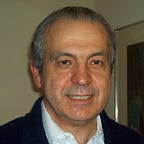The Magic Quad
The Magic Quad is an equilateral quadrilateral with 13 cells, which exhibits 3 solutions (excluding rotations and reflections).
The first two solutions display the same magic sum in 10 different ways. Their magic sums are 17 and 25 respectively:
However, the third solution with a magic sum of 21, is balanced and unique:
This solution maintains the same 10 linear symmetries of the previous two solutions, but in addition it displays 3 more central point symmetries, as highlighted by the colors.
These three extra symmetries are each made by a set of 4 cells: the corners of the Quad (violet), the corners of the inscribed square of order two (yellow), and the corner of the order two inner quad inscribed in the above one (green).
The numbers in these sets of cells add up to the same sum of 28. Since these central symmetries involve four cells, instead of three, it is expected that their magic sum would be higher.
We also notice how the opposite corners of the three squares formed by central symmetries always add up to 14 (7 x 2):
- Violet: 10+4 = 14; and 9+5 = 14;
- Yellow: 2+12 = 14; and 6+8 = 14;
- Green: 13+1 = 14; and 11+3 = 14.
Looking at the solution again, we can see one more linear/center symmetry. The vertical and horizontal diagonals of the main Quad add up to the same number:
- Horizontal main diagonal: 10+13+7+1+4 = 35
- Vertical main diagonal: 9+11+7+3+5 = 35
Finally, we notice that the square with yellow corners inscribed in the Magic Quad is also a classic magic square of order 3, albeit not normal, but with its 8 ways to add up to 21!
We counted already six of these eight ways. The other two are: 13+7+1 = 21, and 11+7+3 = 21.
This solution highlights the relevance of the number 7 in the Magic Quad:
- 7 is the number at the very center of our figure.
- 7 multiplied by 2 (14) gives us the sum of opposite cells in the squares forming central point symmetries.
- 7 multiplied by 3, the number of cells in all linear symmetries with 3 cells, gives us their magic sum of 21.
- The magic sum of 21 is the median between the two other possible magic sums displayed by the first two solutions: 17 and 25.
- 7 multiplied by 4, gives us the magic sum of 28, which is obtained by adding the sets of 4 numbers according to all the center point symmetries of 4 cells, identified in the figure above by color.
- 7 multiplied by 5, gives us the magic sum of 35, which is obtained by adding the numbers in each of the two main diagonals of the Magic Quad.
- 7 multiplied by 9, gives us the total sum of the numbers in the inscribed 3x3 magic square.
- 7 multiplied by 13, the number of cells in our figure, gives us the sum of all the numbers in the Quad: 91.
Have you noticed that, in our unique solution, the numbers on the main vertical axis are the five consecutive odd numbers 3, 5, 7, 9 and 11?
Have you noticed how the set of even numbers and the set of odd numbers are both symmetrically positioned with respect to both the horizontal and vertical axes?
If you enjoyed reading this article you may also enjoy: The Magic Cross and Other Magic Figures; The Magic Windmill; The Magic Spaceship; The Magic Coronene
